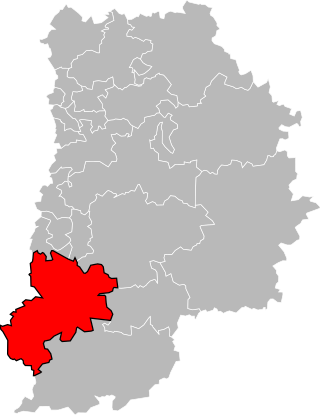Related Research Articles

Yonne is a département in the Bourgogne-Franche-Comté region in France. It is named after the river Yonne, which flows through it, in the country's north-central part. One of Bourgogne-Franche-Comté's eight constituent departments, it is located in its northwestern part, bordering Île-de-France. It was created in 1790 during the French Revolution. Its prefecture is Auxerre, with subprefectures in Avallon and Sens. Its INSEE and postcode number is 89.
Fleury may refer to:

Boutigny-sur-Essonne is a commune in the Essonne department in Île-de-France in northern France.
Villeneuve, LaVilleneuve or deVilleneuve may refer to:
Fontenay can refer to:
Villiers may refer to:
The following is a list of the 23 cantons of the Seine-et-Marne department, in France, following the French canton reorganisation which came into effect in March 2015:
Saint-Maurice is the name or part of the name of places. It refers to the legendary Saint Maurice.

The arrondissement of Fontainebleau is an arrondissement of France in the Seine-et-Marne department in the Île-de-France region. It has 85 communes. Its population is 155,817 (2019), and its area is 1,228.5 km2 (474.3 sq mi).
La Ferté is a French toponym meaning a fortress or bastion, derived from Gallo-Roman firmitate, ultimately from Latin firmus, meaning 'stable or strong.' It is the name or part of the name of several communes in France:
Forges or Les Forges may refer to:

The canton of Fontainebleau is a French administrative division, located in the arrondissement of Fontainebleau, in the Seine-et-Marne département.
The canton of Bray-sur-Seine is a French former administrative division, located in the arrondissement of Provins, in the Seine-et-Marne département. It was disbanded following the French canton reorganisation which came into effect in March 2015. It consisted of 23 communes, which joined the canton of Provins in 2015.

The canton of Provins is a French administrative division, located in the arrondissement of Provins, in the Seine-et-Marne département.

The unchambered long barrowearthen long barrow, non-megalithic long barrow or non-megalithic mound, is a type of long barrow found across the British Isles, in a belt of land in Brittany, and in northern Europe as far east as the River Vistula. The term "unchambered" means that there is no stone chamber within the stone enclosure. In Great Britain they are often known as non-megalithic long barrows or unchambered long cairns.
Patrice Brun is a French archaeologist, a professor at Pantheon-Sorbonne University where he teaches European early history as well as theories and methods of archeology.
The Communauté de communes de la Bassée - Montois is a communauté de communes in the Seine-et-Marne département and in the Île-de-France région of France. It was formed on 1 January 2014 by the merger of the former Communauté de communes de la Bassée and the Communauté de communes du Montois. Its seat is in Donnemarie-Dontilly. Its area is 421.8 km2, and its population was 23,230 in 2019.
References
- ↑ "Reconstruction of the Passy culture long barrow monuments at Fleury-sur-Orne, France".
- ↑ Rivollat, M.; Thomas, A.; Ghesquière, E.; Rohrlach, A. B.; Späth, E.; Pemonge, M. H.; Haak, W.; Chambon, P.; Deguilloux, M. F. (2022). "Ancient DNA gives new insights into a Norman Neolithic monumental cemetery dedicated to male elites". PNAS. 119 (18): e2120786119. Bibcode:2022PNAS..11920786R. doi:10.1073/pnas.2120786119. PMC 9170172 . PMID 35446690.
The cemetery of Fleury-sur-Orne (Normandy, France) belongs to the first monumental funeral manifestations in Europe and predates Atlantic megalithic societies. Established during the second quarter of the fifth millennium calibrated (cal.) BCE, Fleury-sur-Orne consisted of earthen long barrows, some measuring up to 300 m in length. These monuments belong to the "Passy" phenomenon, named after the eponymous site. They are part of the Cerny culture that originated in the Yonne and upper Seine valley region, hereafter called "the Paris Basin," around 4,700 cal. BCE at the beginning of the local Middle Neolithic. The Passy-type monuments or STP (structure de type Passy) then spread to Normandy, where Fleury-sur-Orne is located.
- ↑ L'Étoile Neolithic Camp, Ghislain Lancel (in French)
- ↑ The Neolithic enclosures of l'Étoile, Aerial Archaeology, Roger Agache, Ministry of Culture (in French)
- ↑ Daniel Mordant: Le complexe des Réaudins à Balloy enceinte et nécropole monumentale. In: C. Constantin, D. Mordant, D. Simonin (ed.): La Culture de Cerny, nouvelle économie, nouvelle société au Néolithique. pp. 449-479, 1997; Philippe Chambon: La nécropole de Balloy "les Réaudins", approche archéo-anthropologique. In: C. Constantin, D. Mordant, D. Simonin (eds.): La Culture de Cerny, nouvelle économie, nouvelle société au Néolithique. Actes du colloque international de Nemours, 1994, Mémoires du musée de Préhistoire d'Île-de-France, 6, éd. APRAIF, Nemours, pp. 489-498, 1997
- ↑ Pierre Duhamel: La nécropole monumentale de Passy (Yonne): description d'ensemble et problème d'interprétation. In: C. Constantin, D. Mordant, D. Simonin (eds.): La Culture de Cerny, nouvelle économie, nouvelle société au Néolithique. Actes du colloque international de Nemours, 1994, Mémoires du musée de Préhistoire d'Île-de-France, 6, éd. APRAIF, Nemours, pp. 397-448, 1997
- ↑ F. Müller, Pierre Duhamel, A. Augereau, G. Depierre: Une nouvelle nécropole monumentale Cerny à Gron "les Sablons" (Yonne). Actes du 22e colloque interrégional sur le Néolithique, Strasbourg, 27-29 octobre 1995. Supplement aux Cahiers de l'Association pour la Promotion de la Recherche archéologique en Alsace pp. 103-133, 1997